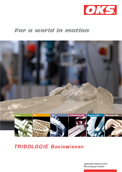If, for structural reasons, no oil lubrication is possible or if a cooling function is not required, a lubricating grease is used in most cases. Greases consist of a base oil that is bound by a thickener (soap). This ensures that the lubricant remains at the lubricating point. There it ensures permanently effective protection against friction and wear and seals the lubricating point against external influences such as moisture and foreign matter. Greases are often used at rolling and friction bearings, spindles, fittings, seals, guides, but also at chains and gears.
Characteristics of greases
| Characteristic | Standard | Description |
| Base oil viscosity | DIN 51561 | Influences the speed range and load capacity of a grease |
| Drop point | DIN ISO 2176 | Exceeding of this temperature results in destruction of the grease structure |
| Operating temperature | DIN 51805 DIN 51821/2 (Wälzlager) |
Temperature range of the optimal performance at roller bearing greases |
| Speed parameter (DN value) |
|
Maximum rotating speed up to which a grease can be used in a roller bearing |
| Consistency | DIN ISO 2137 | Dimension for the stability of a grease (worked/unworked penetration) |
| NLGI grade | DIN 51818 | Classification to the consistency classes to DIN ISO 2137 |
| Four-ball test | DIN 51350 | Determining of the wear protection and of the maximum load capacity of a roller bearing grease |
Structure of greases
The main difference in the structure of greases compared to oil is the thickener which determines the typical performance features of a grease. Modern lubricating greases are formulated so that their active ingredients form an emergency running lubricating film in case of critical stresses and ensure operational reliability.
| Thickener (soap) |
Operating temperature [ °C] |
Operating temperature [ °C] Syntheseöl |
Drop point [ °C] | Water resistance | Load capacity |
| Calcium | -30 -> +50 | n.a. | <100 |
++ |
+ |
| Lithium | -35 -> +120 | -60 -> +160 | 170/200 |
+ |
- |
| Al-complex | -30 -> +140 | -60 -> +160 | >230 |
+ |
- |
| Ba-complex | -25 -> +140 | -60 -> +160 | >220 |
++ |
++ |
| Ca-complex | -30 -> +140 | -60 -> +160 | >190 |
++ |
++ |
| Li-complex | -40 -> +140 | -60 -> +160 | >220 |
+ |
- |
| bentonitee | -40 -> +140 | -60 -> +180 | ohne |
+ |
- |
| Polycarbamide | -30 -> +160 | -40 -> +160 | 250 |
+ |
- |
Compatibility of greases
In addition to the compatibility of the base oils, the miscibility of the thickeners has to be taken into account when changing greases. An incompatibility has a negative influence on the performance of the lubricating grease.
| Ca-soap | Cax-soap | Li-soap | Lix-Seife | Li / Ca- soap |
Na-soap | bentonitee | Bax-soap | Alx-soap | Polycarbamide | |
|---|---|---|---|---|---|---|---|---|---|---|
| Ca-soap | ■ | ■ | ■ | ■ | ■ | ■ | ■ | ■ | ||
| Cax-soap | ■ | ■ | ■ | ■ | ■ | ■ | ■ | ■ | ||
| Li-soap | ■ | ■ | ■ | ■ | ■ | ■ | ■ | ■ | ||
| Lix-soap | ■ | ■ | ■ | ■ | ■ | ■ | ■ | |||
| Li / Ca-soap | ■ | ■ | ■ | ■ | ■ | ■ | ■ | ■ | ||
| Na-soap | ■ | ■ | ■ | ■ | ||||||
| bentonitee | ■ | ■ | ■ | ■ | ■ | ■ | ■ | ■ | ||
| Bax-soap | ■ | ■ | ■ | ■ | ■ | ■ | ■ | ■ | ■ | ■ |
| Alx-soap | ■ | ■ | ■ | ■ | ||||||
| Polycarbamide | ■ | ■ | ■ | ■ | ■ | ■ | ■ | ■ | ■ |
■ miscible
Greases for long-term lubrication under critical operation conditions
Consistency of a lubricating grease
At lubricating greases the consistency is the characteristic for assessing the strength of a grease. According to DIN ISO 2137 it is measured through the penetration depth of a standardised cone.
Classification of greases to NLGI
The classification according to NLGI (DIN 51 818) ranges from very soft (Class 000) to very firm (Class 6). Standard lubricating greases usually comply with NLGI Class 2.
| NLGI-class | Worked penetration [mm /10] |
Gear lubrication | Friction bearings | Roller bearings | Water pumps | Block greases |
|---|---|---|---|---|---|---|
| 000 | 445 – 475 | ■ | ||||
| 00 | 400 – 430 | ■ | ||||
| 0 | 355 – 385 | ■ | ||||
| 1 | 310 – 340 | ■ | ■ | ■ | ||
| 2 | 265 – 295 | ■ | ■ | |||
| 3 | 220 – 250 | ■ | ■ | |||
| 4 | 175 – 205 | ■ | ■ | |||
| 5 | 130 – 160 | ■ | ||||
| 6 | 85 – 115 Unworked penetration |
■ |
Designation and classification of lubricating greases to DIN 51 502
In view of the multiple possibilities of application and different compositions, lubricating greases are classified and described according to DIN 51 502 by various aspects such as type of lubricating grease, usability, consistency classes (NLGI) and operating temperatures.


